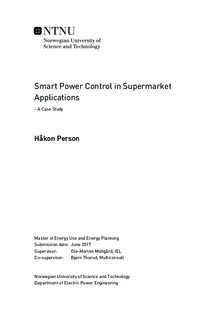| dc.description.abstract | In this study, smart power control system strategies for Norwegian supermarket applications are investigated. The relevance of smart power control systems is supported by trends in the market and the political environment. Examples include political goals regarding increased penetration of renewable electricity in the grid, economic incentives found in electricity pricing schemes, an increased number of Norwegian prosumers, technical challenges opposed on utility companies and new available technologies.
The stated power control goals are to increase the degree of self-sufficiency by local PV generation and to decrease yearly electricity costs. The means of mitigating electricity costs are peak shaving and load shifting from high price to low price periods, principles which are graphically described in Figure 6. The supermarket KIWI Dalgård, which is under construction and located in Trondheim, is selected as the case study. It is used as a common thread for discussing alternative solutions and making design choices for the various subsystems and strategies which compose the suggested power control systems.
To make a basis for a realistic power control design, load data are gathered as historical data with hourly values for a full year. Applied electricity cost elements are real data from Nord Pool Spot and the local utility company Trønderenergi, for the investigated period May 2016 to May 2017. Insight into load data has been obtained by granted access to the energy monitoring database of KIWI, along with conversations with key KIWI personnel. To form a basis for power control design for a full year and to assess the internal flexibility of the loads, the load data has been studied with a daily, seasonal and yearly perspective as well as distributed on load types. A detailed model of the PV system planned at KIWI Dalgård has also been built in the simulation software PVsyst. Based on the load and generation curves of KIWI Dalgård, an evaluation of convenient storage technologies has been made, of which a thermal PCM storage solution was decided to be included in the case study simulations.
A study of global research publications has been used to identify suggested smart power control strategies which are to be evaluated in a case study context. To support understanding and relevance of the discussed systems, technical theory is generally supported with system examples and available solutions in themarket when found. Included in the scope is the power control system context, which forms an important part of the decision basis. The basic architecture of a building automation system (BAS) is described as it forms
the system to which the smart power control is to be adapted. Different stakeholders and their goals are discussed, as it forms a basis for how the system should be set up. A potential saving assessment for the case study is included as it gives guidelines of which equipment and complexitywhich can be justified when designing a power control system. After an overall assessment, a real time fuzzy logic control system and an optimized scheduling system have been chosen as alternatives to be further investigated for the case study. A full year of hourly simulations has been conducted, and results are compared for the suggested control schemes. Additionally, a sensitivity and scenario analysis is conducted to evaluate control system performance in different situations.
The proposed power control strategies of fuzzy logic real time control and optimized dispatch performed technically well according to the stated control objectives, however it proved difficult to generate economic
revenue. The best performing control structure was the optimized scheduling system, which mitigated yearly electricity costs by 3.5 % and obtained a degree of self-consumption of 99.3 %. The largest savings were obtained by peak shaving. The main reason for the low savings obtained was the small potential for smart power control found in the case study, which was recognized by low consumption, flat load curves and 97 % direct self-consumption of PV electricity by the loads before smart power control was applied. For such a case, no control or a simple real time control structure requiring a minimum level of set-up time and installations seems to be most economically viable. Other constraints were market based, such as low energy grid tariffs and low variation in the hourly spot price. Still, the technical performance of smart power control systems was demonstrated, and the systems are believed to be attractive in more suitable applications. The relevance of smart power control increases with large grid tariffs, excess of distributed generation, sharp peak loads, large variation of electricity prices, and the number of synergies which can be integrated so that alternative cost components may be reduced. | |

